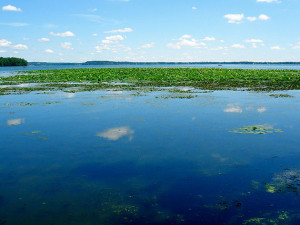Single-cell genomics sheds light on nutrient and carbon cycling in Actinobacteria.
The Science:
Researchers assembled and compared draft genomes of acI Actinobacteria from single cells collected in four freshwater lakes in the United States and Europe.

Single cells of acI Actinobacteria were isolated from samples collected in Lake Mendota, Wisconsin. (Ann Althouse via Flickr, CC BY-NC 2.0)
The Impact:
The single cells collected represented three different acI tribes of Actinobacteria, allowing researchers to learn more about their roles in carbon and other nutrient cycling.
Summary
Among the most ubiquitous microbes in freshwater ecosystems are members of the acI lineage of Actinobacteria. By some estimates they account for as much as 50 percent of the plankton in freshwater lakes and rivers all over the world, and yet researchers still don’t know exactly what ecological role these microbes play, and how they influence the carbon cycle. As reported in a study published online ahead of print on August 5, 2014 in The ISME Journal, a team including researchers from the U.S. Department of Energy Joint Genome Institute (DOE JGI), a DOE Office of Science user facility, harnessed single-cell genomics to learn more about these microbes and their lifestyles.
Prior to this study, only one nearly complete genome of an acI bacterium had been sequenced. For this work, which was supported in part by the DOE JGI Community Science Program, water samples were collected from Lakes Mendota and Sparkling in Wisconsin, Lake Damariscotta in Maine, and from Lake Stechlin in Germany. From these samples, draft assemblies of 10 single amplified genomes (SAGs) representing three acI tribes were generated at the DOE JGI. These 10 SAGs were then compared against a SAG previously sequenced in another study to get a better idea of which traits had been conserved within the acI lineage, as well as how the three acI groups represented differed from one another.
Though none of the sequenced draft genomes of single cells isolated from freshwater were complete, the team did find genes for several conserved traits such as central metabolism, shared across all three acI tribes. Additionally, many of the SAGs contained an enzyme that allowed acI bacteria to access a compound synthesized by cyanobacteria that stores both carbon and nitrogen. The team also made preliminary attempts to find out if each tribe of acI bacteria had genes associated with a particular ecological niche, but having incomplete genomes made it difficult to derive any conclusions. “Members of the acI lineage are clearly specialized relative to their parent order (Actinomycetales) and other sequenced freshwater bacteria,” the team concluded. “Their highly streamlined genomes and small cell size suggest they share broad niche dimensions with ultramicro- bacteria such as freshwater members of the SAR11 clade. Although many characteristics of the SAGs analyzed here were consistent with the only other previously published acI genome… investigating three different tribes showed ecological differentiation among them.”
Contact
Katherine McMahon
University of Wisconsin
kdmcmahon@wisc.edu
Funding
- U.S. Department of Energy Office of Science
- National Science Foundation
- Long Term Ecological Research Program
- Wenner-Gren Foundation
- Swedish Research Council
- German Science Foundation
Publication
Ghylin TW et al. Comparative single-cell genomics reveals potential ecological niches for the freshwater acI Actinobacteria lineage. ISME J. 2014 Aug 5. doi: 10.1038/ismej.2014.135. [Epub ahead of print]